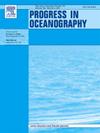Observing ENSO-modulated tides from space
IF 3.6
3区 地球科学
Q1 OCEANOGRAPHY
引用次数: 0
Abstract
The understanding of sea level variability is fundamental for coastal communities with high population density. As important parts of sea levels, tides are often overlooked because they tend to be regarded as simple periodic oscillations by numerous studies. In fact, due to the interference of various non-astronomical factors, observed tides are non-stationary and display multi-time scale variability. Here, we focus on inter-annual tidal variations induced by El Niño-Southern Oscillation (ENSO) in the western Pacific. Although satellite altimeters have been widely used in tidal research, to date, inter-annual tidal changes from satellite altimeters are never reported. Classical harmonic analysis (CHA) model with moving windows is inappropriate for satellite altimeter records due to tidal aliasing originated from long-period sampling intervals. In this paper, we successfully quantify the influences of ENSO on tides from multi-satellite altimeters through a revised harmonic analysis (RHA) model which directly builds ENSO forcing into the basic functions of CHA. To eliminate mathematical artifacts caused by over-fitting, Lasso regularization is applied in the RHA model to replace widely-used ordinary least squares. The performances of RHA are generally better than those of CHA as a result of considering the impacts of ENSO. The combination of RHA and satellite altimeters extends the studies on tidal evolution using spatially limited tide gauges. Compared to diurnal tides, it is found that semi-diurnal tides are more vulnerable to ENSO in the western Pacific. Of note, both linear and non-linear tidal responses to ENSO show significant spatial heterogeneity. Moreover, as a universal method, ENSO index used in this study can be replaced by other factors such as river flow and sea waves to explore tidal evolution driven by other physical processes.
从太空观测enso调制的潮汐
了解海平面变化对人口密度高的沿海社区至关重要。作为海平面的重要组成部分,潮汐常常被忽视,因为它们往往被许多研究视为简单的周期性振荡。实际上,由于各种非天文因素的干扰,观测到的潮汐是非平稳的,呈现出多时间尺度的变率。本文重点研究了El Niño-Southern涛动(ENSO)在西太平洋引起的年际潮汐变化。虽然卫星高度计已广泛用于潮汐研究,但迄今为止,卫星高度计的年际潮汐变化从未报道过。由于长周期采样间隔引起的潮汐混叠,传统的带移动窗口的谐波分析模型不适合用于卫星高度计记录。本文通过修正的谐波分析(RHA)模型,将ENSO强迫直接构建到CHA的基本函数中,成功地量化了多卫星高度计的ENSO对潮汐的影响。为了消除过度拟合引起的数学伪影,在RHA模型中应用Lasso正则化来取代广泛使用的普通最小二乘。由于考虑了ENSO的影响,RHA的性能普遍优于CHA。RHA与卫星高度计的结合扩展了利用空间有限的潮汐计对潮汐演变的研究。与日潮相比,西太平洋的半日潮更容易受到ENSO的影响。值得注意的是,潮汐对ENSO的线性和非线性响应均表现出显著的空间异质性。此外,本研究使用的ENSO指数作为一种通用的方法,可以用河流流量和海浪等其他因素代替,来探索其他物理过程驱动的潮汐演变。
本文章由计算机程序翻译,如有差异,请以英文原文为准。
求助全文
约1分钟内获得全文
求助全文
来源期刊

Progress in Oceanography
地学-海洋学
CiteScore
7.20
自引率
4.90%
发文量
138
审稿时长
3 months
期刊介绍:
Progress in Oceanography publishes the longer, more comprehensive papers that most oceanographers feel are necessary, on occasion, to do justice to their work. Contributions are generally either a review of an aspect of oceanography or a treatise on an expanding oceanographic subject. The articles cover the entire spectrum of disciplines within the science of oceanography. Occasionally volumes are devoted to collections of papers and conference proceedings of exceptional interest. Essential reading for all oceanographers.
 求助内容:
求助内容: 应助结果提醒方式:
应助结果提醒方式:


